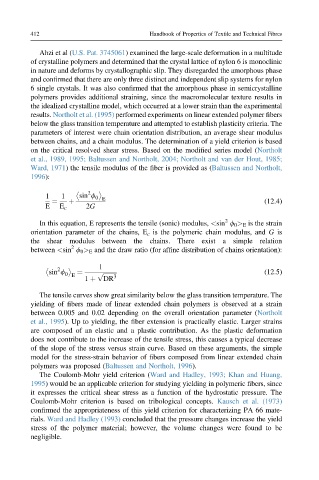Page 439 - Handbook of Properties of Textile and Technical Fibres
P. 439
412 Handbook of Properties of Textile and Technical Fibres
Ahzi et al (U.S. Pat. 3745061) examined the large-scale deformation in a multitude
of crystalline polymers and determined that the crystal lattice of nylon 6 is monoclinic
in nature and deforms by crystallographic slip. They disregarded the amorphous phase
and confirmed that there are only three distinct and independent slip systems for nylon
6 single crystals. It was also confirmed that the amorphous phase in semicrystalline
polymers provides additional straining, since the macromolecular texture results in
the idealized crystalline model, which occurred at a lower strain than the experimental
results. Northolt et al. (1995) performed experiments on linear extended polymer fibers
below the glass transition temperature and attempted to establish plasticity criteria. The
parameters of interest were chain orientation distribution, an average shear modulus
between chains, and a chain modulus. The determination of a yield criterion is based
on the critical resolved shear stress. Based on the modified series model (Northolt
et al., 1989, 1995; Baltussen and Northolt, 2004; Northolt and van der Hout, 1985;
Ward, 1971) the tensile modulus of the fiber is provided as (Baltussen and Northolt,
1996):
2
1 1 sin f 0 E
¼ þ (12.4)
E E c 2G
2
In this equation, E represents the tensile (sonic) modulus, <sin f 0 > E is the strain
orientation parameter of the chains, E c is the polymeric chain modulus, and G is
the shear modulus between the chains. There exist a simple relation
2
between <sin f 0 > E and the draw ratio (for affine distribution of chains orientation):
1
2
sin f ¼ p (12.5)
0 E ffiffiffiffiffiffiffiffiffi 3
1 þ DR
The tensile curves show great similarity below the glass transition temperature. The
yielding of fibers made of linear extended chain polymers is observed at a strain
between 0.005 and 0.02 depending on the overall orientation parameter (Northolt
et al., 1995). Up to yielding, the fiber extension is practically elastic. Larger strains
are composed of an elastic and a plastic contribution. As the plastic deformation
does not contribute to the increase of the tensile stress, this causes a typical decrease
of the slope of the stress versus strain curve. Based on these arguments, the simple
model for the stress-strain behavior of fibers composed from linear extended chain
polymers was proposed (Baltussen and Northolt, 1996).
The Coulomb-Mohr yield criterion (Ward and Hadley, 1993; Khan and Huang,
1995) would be an applicable criterion for studying yielding in polymeric fibers, since
it expresses the critical shear stress as a function of the hydrostatic pressure. The
Coulomb-Mohr criterion is based on tribological concepts. Kausch et al. (1973)
confirmed the appropriateness of this yield criterion for characterizing PA 66 mate-
rials. Ward and Hadley (1993) concluded that the pressure changes increase the yield
stress of the polymer material; however, the volume changes were found to be
negligible.

